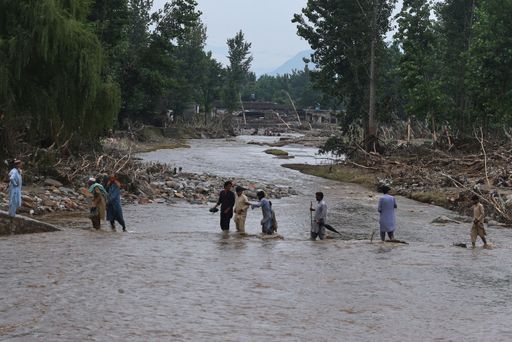In the flood-ravaged district of Buner in northern Pakistan, 17-year-old Muhammad Sudais stands amid the remains of what used to be his home.
“I remained helpless when I lost my family members and all our belongings in the devastating flash floods of August 15,” he says.
His is just one story among thousands emerging from Khyber Pakhtunkhwa (KP), where days of torrential rain have triggered flash floods that wiped out entire villages, bridges, and roads — killing more than 368 people in just four days.
According to officials, the national death toll has now risen to 688 since the first monsoon spells hit in late June. Another 18 people were killed on Monday as fresh rains lashed the region, and at least 200 remain missing, mostly from Buner district.
The disaster has not only overwhelmed the region’s infrastructure but has also stretched relief efforts to their limit.
‘Devastating situations’
Emergency teams from Islamic Relief, a humanitarian aid organisation working in Pakistan, were among the first responders in Buner, Swat, and Shangla — the worst-hit districts.
Syed Naheed Shah, who has been leading field operations in the region, described the conditions as some of the worst he’s ever seen.
“We have never witnessed such devastating situations, especially in Buner,” Shah told TRT World during a call from Shangla.
“In the first two days, hospitals were completely packed with the dead and injured. People are still searching for missing family members.”
Access remains a major challenge, with debris, collapsed roads, and landslides obstructing relief efforts.
“Roads are blocked, infrastructure has collapsed, and muddy floodwater is everywhere. It’s making it extremely difficult to reach remote villages where help is urgently needed,” he said.
A government spokesperson confirmed to reporters on Monday that rescue teams and the army are working with volunteers to recover bodies and search for the missing.
In many places, locals have fled to nearby hills and damaged bridges to seek shelter.

Aid efforts continue despite challenges
Raza Narejo, Country Director of Islamic Relief Pakistan, said their teams were on the ground within hours of the flooding.
“We assessed the damage and began distributing hot meals, clean drinking water, and hygiene kits for women and newborns,” Narejo said.
“In the coming days, we plan to distribute kitchen utensils and other essentials.”
But the scale of destruction is immense.
“Agriculture has been destroyed, livestock perished, and almost all schools in the affected districts are damaged — disrupting education for thousands of children,” he told TRT World.
“Stagnant water and rubble are also raising the risk of disease outbreaks.”
Among the most urgent needs now, Narejo listed: emergency food and water supplies for 10,000 families, water and sanitation services, medical supplies and healthcare access and debris removal and shelter materials.
The National Disaster Management Authority (NDMA) has confirmed the destruction of hundreds of homes, schools, and public buildings in KP. Preliminary estimates suggest over $445,000 in property damage, according to a statement from the prime minister’s office.
Pharmacy lost, families torn apart
Sher Awan, a local pharmacist in Kuzpow village, Shangla, shared how his livelihood — and that of 200 families relying on him for basic health advice and medicines — was washed away.
“All the medicines at my store were wasted in the floods. I’m worried about what will come next,” he told TRT World.
He had just stocked his shop with medicines worth nearly 700,000 rupees before it was submerged.
Now, his community faces both emotional and medical crises without basic supplies.
Aid workers say stories of unimaginable loss are being reported daily. Shah recalled one mother and daughter wandering through flood debris in search of their missing father.
“People are not only struggling to survive — they’re mourning, searching, and trying to hold onto hope,” he said.
Syed Masood Shah, another Buner resident, shared his pain: “Losing 11 family members in a single night has shattered my life — I feel completely alone.”
A race against time
Despite the massive challenges, along with the NDMA, Al-Khidmat Foundation and Islamic Relief, several relief organisations have dispatched relief goods to the affected areas.
Rapid needs assessments have been completed, and relief distribution continues. But as the days go by, conditions risk deteriorating further without urgent outside support.
“We’re doing everything we can,” said Narejo. “But to prevent further tragedy, we need more hands, more supplies, and faster access.”
As the true scale of the disaster continues to unfold, aid workers on the ground are calling for urgent support to prevent further suffering — and to help devastated communities begin the long process of rebuilding.
Pakistan remains one of the world’s most climate-vulnerable countries. The intensity of this year’s monsoon is estimated to be 50–60% higher than last year, according to the NDMA.
Flash floods and landslides are becoming more frequent and destructive.
In 2022, a third of the country was submerged during monsoon flooding, claiming over 1,700 lives. This year’s devastation, though more localised, is once again pushing communities to the brink.




















